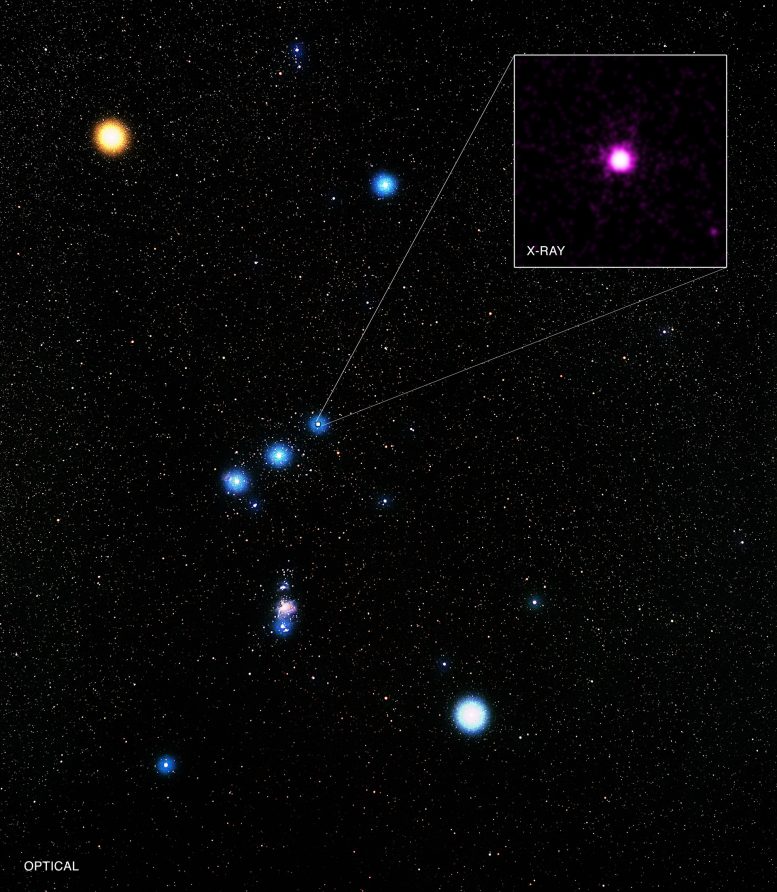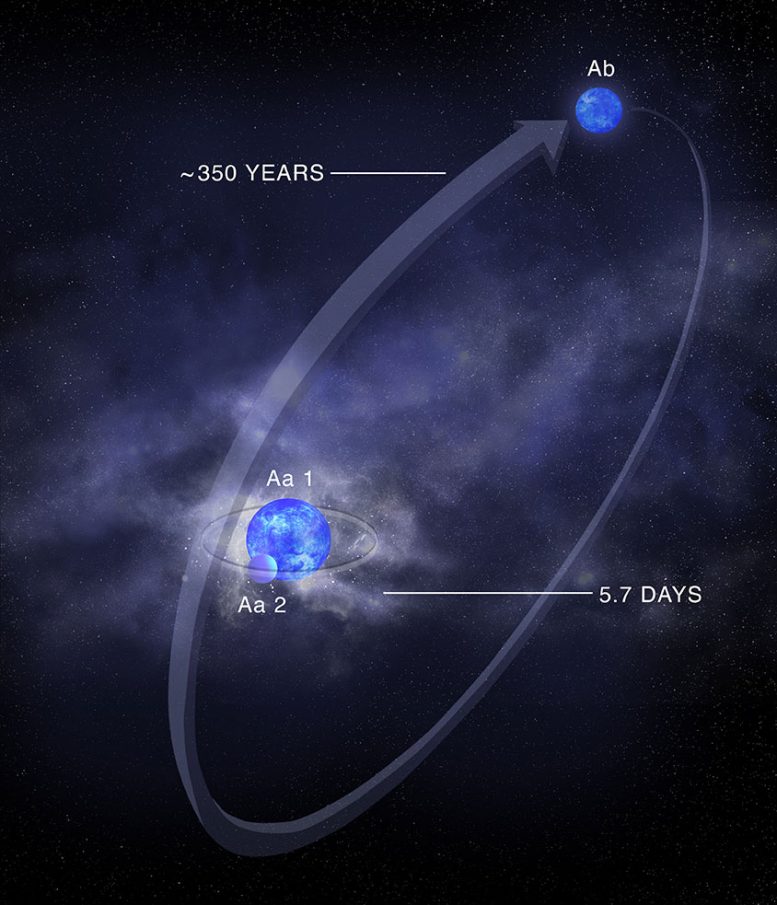
Delta Orionis is a complex star system that contains five stars in total. Two of those stars are in a close orbit where one passes in front of another from the vantage point of Earth, which helps astronomers learn more about their properties. The massive stars in this pair are so bright that their radiation blows powerful winds of stellar material away, affecting the chemical and physical properties of the gas in their host galaxies. Credit: X-ray: NASA/CXC/GSFC/M.Corcoran et al.; Optical: Eckhard Slawik
Delta Orionis is a complex star system and constitutes the westernmost star in the “belt” of the Orion constellation. By observing this system NASA’s Chandra X-ray Observatory, astronomers have discovered new information about these stars.
One of the most recognizable constellations in the sky is Orion, the Hunter. Among Orion’s best-known features is the “belt,” consisting of three bright stars in a line, each of which can be seen without a telescope.
The westernmost star in Orion’s belt is known officially as Delta Orionis. (Since it has been observed for centuries by sky-watchers around the world, it also goes by many other names in various cultures, like “Mintaka”.) Modern astronomers know that Delta Orionis is not simply one single star, but rather it is a complex multiple star system.
Delta Orionis is a small stellar group with three components and five stars in total: Delta Ori A, Delta Ori B, and Delta Ori C. Both Delta Ori B and Delta Ori C are single stars and may give off small amounts of X-rays. Delta Ori A, on the other hand, has been detected as a strong X-ray source and is itself a triple star system as shown in the artist’s illustration.
In Delta Ori A, two closely separated stars orbit around each other every 5.7 days, while a third star orbits this pair with a period of over 400 years. The more massive, or primary, star in the closely-separated stellar pair weighs about 25 times the mass of the Sun, whereas the less massive, or secondary star, weighs about ten times the mass of the Sun.
The chance alignment of this pair of stars allows one star to pass in front of the other during every orbit from the vantage point of Earth. This special class of star system is known as an “eclipsing binary,” and it gives astronomers a direct way to measure the mass and size of the stars.
Massive stars, although relatively rare, can have profound impacts on the galaxies they inhabit. These giant stars are so bright that their radiation blows powerful winds of stellar material away, affecting the chemical and physical properties of the gas in their host galaxies. These stellar winds also help determine the fate of the stars themselves, which will eventually explode as supernovas and leave behind a neutron star or black hole.

This artist’s illustration depicts the system of Delta Orionis A. In the center, two closely separated stars orbit around each other every 5.7 days and this pair is known as Delta Orionis Aa. The more massive, or primary, star in Delta Orionis Aa weighs about 25 times the mass of the Sun, whereas the less massive, or secondary star, weighs about ten times the mass of the Sun. The chance alignment of this pair of stars allows one star to pass in front of the other during every orbit from the vantage point of Earth. This special class of star system is known as an “eclipsing binary,” and it gives astronomers a direct way to measure the mass and size of the stars. Meanwhile, a third star, dubbed Delta Orionis Ab, orbits the eclipsing binary with a period of over 400 years. Credit: NASA/CXC/M.Weiss
By observing this eclipsing binary component of Delta Orionis A (dubbed Delta Ori Aa) with NASA’s Chandra X-ray Observatory for the equivalent of nearly six days, a team of researchers gleaned important information about massive stars and how their winds play a role in their evolution and affect their surroundings. The Chandra image is seen in the inset box at the top of page in context with an optical view of the Orion constellation obtained from a ground-based telescope.
Since Delta Ori Aa is the nearest massive eclipsing binary, it can be used as a decoder key for understanding the relation between the stellar properties derived from optical observations, and the properties of the wind, which are revealed by X-ray emission.
The lower-mass companion star in Delta Ori Aa has a very weak wind and is very faint in X-rays. Astronomers can use Chandra to watch as the companion star blocks out various parts of the wind of the more massive star. This allows scientists to better see what happens to the X-ray-emitting gas surrounding the primary star, helping to answer the long-standing question of where in the stellar wind the X-ray-emitting gas is formed. The data show that most of the X-ray emission comes from the wind of the giant star, and is likely produced by shocks resulting from collisions between rapidly-moving clumps of gas embedded within the wind.
The researchers also found that the X-ray emission from certain atoms in the wind of Delta Ori Aa changes as the stars in the binary move around. This may be caused by collisions between winds from the two stars, or from a collision of the wind from the primary star with the surface of the secondary star. This interaction, in turn, obstructs some of the wind from the brighter star.
Parallel optical data from the Canadian Space Agency’s Microvariability and Oscillation of Stars Telescope (MOST) revealed evidence for oscillations of the primary star produced by tidal interactions between the primary and companion star as the stars travel in their orbits. Measurements of the changes of brightness in optical light plus detailed analysis of optical and ultraviolet spectra were used to refine the parameters of the two stars. The researchers were also able to resolve some previously claimed inconsistencies between the stellar parameters and models of how the stars are expected to evolve with time.
These results were published in four coordinated papers that were recently published in The Astrophysical Journal led by Michael Corcoran (NASA’s Goddard Space Flight Center & Universities Space Research Association), Joy Nichols (Harvard-Smithsonian Center for Astrophysics), Herbert Pablo (University of Montreal), and Tomer Shenar (University of Potsdam). NASA’s Marshall Space Flight Center in Huntsville, Alabama, manages the Chandra program for NASA’s Science Mission Directorate in Washington. The Smithsonian Astrophysical Observatory in Cambridge, Massachusetts, controls Chandra’s science and flight operations.
References:
“A Coordinated X-ray and Optical Campaign on the Nearest Massive Eclipsing Binary, Delta Ori Aa: I. Overview of the X-ray Spectrum” by M. F. Corcoran, J. S. Nichols, H. Pablo, T. Shenar, A. M. T. Pollock, W. L. Waldron, A. F. J. Moffat, N. D. Richardson, C. M. P. Russell, K. Hamaguchi, D. P. Huenemoerder, L. Oskinova, W.-R. Hamann, Y. Naze, R. Ignace, N. R. Evans, J. R. Lomax, J. L. Hoffman, K. Gayley, S. P. Owocki, M. Leutenegger, T. R. Gull, K. T. Hole, J. Lauer and R. C. Iping, 22 July 2015, The Astrophysical Journal.
DOI: 10.1088/0004-637X/809/2/132
arXiv:1507.05101
“A Coordinated X-ray and Optical Campaign of the Nearby Massive Binary δ Orionis Aa: II. X-ray Variability” by J. S. Nichols, D. P. Huenemoerder, M. F. Corcoran, W. Waldron, Y. Nazé, A. M. T. Pollock, A. F. J. Moffat, J. Lauer, T. Shenar, C. M. P. Russell, N. D. Richardson, H. Pablo, N R. Evans, K. Hamaguchi, T. Gull, W. R. Hamann, L. Oskinova, R. Ignace, Jennifer L. Hoffman, K. T. Hole and J. R. Lomax, 22 July 2015, The Astrophysical Journal.
DOI: 10.1088/0004-637X/809/2/133
arXiv:1507.04972
“A Coordinated X-ray and Optical Campaign of the Nearest Massive Eclipsing Binary, delta Orionis Aa: III. Analysis of Optical Photometric MOST and Spectroscopic (Ground Based) Variations” by Herbert Pablo, Noel D. Richardson, Anthony F. J. Moffat, Michael Corcoran, Tomer Shenar, Omar Benvenuto, Jim Fuller, Yael Naze, Jennifer L. Hoffman, Anatoly Miroshnichenko, Jesus Maiz Apellaniz, Nancy Evans, Thomas Eversberg, Ken Gayley, Ted Gull, Kenji Hamaguch, Wolf-Rainer Hamann, Huib Henrichs, Tabetha Hole, Richard Ignace, Rosina Iping, Jennifer Lauer, Maurice Leutenegger, Jamie Lomax, Joy Nichols, Lida Oskinova, Stan Owocki, Andy Pollock, Christopher M. P. Russell, Wayne Waldron, Christian Buil, Thierry Garrel, Keith Graham, Bernard Heathcote, Thierry Lemoult, Dong Li, Benjamin Mauclaire, Mike Potter, Jose Ribeiro, Jaymie Matthews, Chris Cameron, David Guenther, Rainer Kuschnig, Jason Rowe, Slavek Rucinski, Dimitar Sasselov and Werner Weiss, 29 April 2015, The Astrophysical Journal.
DOI: 10.1088/0004-637X/809/2/134
arXiv:1504.08002
“A coordinated X-ray and Optical Campaign of the Nearest Massive Eclipsing Binary, δ Orionis Aa: IV. A multiwavelength, non-LTE spectroscopic analysis” by T. Shenar, L. Oskinova, W.-R. Hamann, M. F. Corcoran, A. F. J. Moffat, H. Pablo, N. D. Richardson, W. L. Waldron, D. P. Huenemoerder, J. Maíz Apellániz, J. S. Nichols, H. Todt, Y. Nazé, J. L. Hoffman, A. M. T. Pollock and I. Negueruela, 11 March 2015, The Astrophysical Journal.
DOI: 10.1088/0004-637X/809/2/135
arXiv:1503.03476









Why does the article say “Western most” star in the belt yet the provided image shows the “eastern most” star in the enlargement box.
I’m confused.
Hold your laptop over head like a sky chart to match the constellation and you will see that this is the westernmost star.
Doesn’t three stars in orbital relationship equal a trinary system?
“Massive stars, although relatively rare, can have profound impacts on the galaxies they inhabit”
Since we inhabit the same galaxy what would be the effects on Earth or the galaxy in general?
Delta Ori Ab – illustration indicates an orbital period of approximately 350 years, text says “over 400 years” (in two places). Which is correct?
Also isn’t saying “These giant stars are so bright that their radiation blows powerful winds of stellar material away, affecting the chemical and physical properties of the gas in their host galaxies” a bit misleading? (Since, a) they probably only affect a very small part of the galaxy and may well not blow anything out of the galaxy, and b) the “host” galaxy in this case is our home galaxy.}
The Marshall Space Flight Center and Chandra X-ray Observatory both have the mistake. Since the image is an illustration I’m leaning towards 400 as the correct number.